Bio-Inspired Helicoidal Composite Structure Featuring Graded Variable Ply Pitch under Transverse Tensile Loading
Abstract
1. Introduction

2. Experimental Study
2.1. Bio-Inspired Helicoidal Laminates Manufacturing Limitation
2.2. Laminate Manufacturing
2.3. Testing Method
2.4. Numerical Study
3. Results and Discussion
3.1. Numerical Results
3.1.1. Influence of Laminate Thickness on Stress Distribution
3.1.2. Influence of Bio-Inspired Configuration on Stress Distribution
3.1.3. Influence of Bio-Inspired Configuration on Crack Morphology
3.2. Experimental Results
Influence of Bio-Inspired Configuration on Failure Load
3.3. Discussion
4. Conclusions
- The numerical simulation indicates that the selected thickness of the laminates (3 mm) is sufficiently thin to keep the stress concentration effect on transverse tensile strength negligible.
- The numerical study also indicated that delamination is prone to happen more in unidirectional laminates than in bio-inspired laminates.
- The failure mechanism is significantly impacted by the angle between the layers. Where all layers are stacked in a 0-degree direction, the crack path is straight, making delamination more prone. Conversely, by introducing variations in the stacking sequence and incorporating bio-inspired laminates like helicoidal and gradual configurations, the crack path becomes longer and complex. Consequently, it is anticipated that both gradual and helicoidal laminates will exhibit greater strength when compared to unidirectional composites.
- A rise in displacement at failure load was noted for both gradual and helicoidal configurations, showing an increase of 17% and 5%, respectively, compared to the reference unidirectional composite.
- The gradual configuration demonstrates the highest strength (17% and 11% improvement in comparison with unidirectional and helicoidal configurations), attributed to the more intricate failure mechanism obtained through both numerical simulations and experimental observations.
Author Contributions
Funding
Data Availability Statement
Acknowledgments
Conflicts of Interest
References
- Karataş, M.A.; Gökkaya, H. A review on machinability of carbon fiber reinforced polymer (CFRP) and glass fiber reinforced polymer (GFRP) composite materials. Def. Technol. 2018, 14, 318–326. [Google Scholar] [CrossRef]
- Clyne, T.W.; Hull, D. An Introduction to Composite Materials, 3rd ed.; Cambridge University Press: Cambridge, UK, 2019. [Google Scholar] [CrossRef]
- Shah, S.H.; Megat-Yusoff, P.S.M.; Karuppanan, S.; Choudhry, R.S.; Ahmad, F.; Sajid, Z.; Gerard, P.; Sharp, K. Performance comparison of resin-infused thermoplastic and thermoset 3D fabric composites under impact loading. Int. J. Mech. Sci. 2021, 189, 105984. [Google Scholar] [CrossRef]
- Peters, S.T. Introduction, Composite Basics and Road Map. In Handbook of Composites; Peters, S.T., Ed.; Springer: Boston, MA, USA, 1998; pp. 1–20. [Google Scholar] [CrossRef]
- Reddy, J.N. Mechanics of Laminated Composite Plates and Shells, 2nd ed.; CRC Press: Boca Raton, FL, USA, 2003. [Google Scholar] [CrossRef]
- Liu, L.; Zhang, X.; Wang, Z.; Wang, Y.; Guo, J. Micromechanics Modeling of Transverse Tensile Strength for Unidirectional CFRP Composite. Materials 2022, 15, 8577. [Google Scholar] [CrossRef] [PubMed]
- Shah, S.P.; Maiarù, M. analytical model for composite transverse strength based on computational micromechanics. Int. J. Multiscale Comput. Eng. 2023, 21, 77–97. [Google Scholar] [CrossRef]
- Camanho, P.P.; Dávila, C.G.; Pinho, S.T.; Iannucci, L.; Robinson, P. Prediction of in situ strengths and matrix cracking in composites under transverse tension and in-plane shear. Compos. Part A Appl. Sci. Manuf. 2006, 37, 165–176. [Google Scholar] [CrossRef]
- Malekinejad, H.; Ramezani, F.; Carbas, R.J.C.; Marques, E.A.S.; Ferreira, A.M.; da Silva, L.F.M. Study of CFRP Laminate Gradually Modified throughout the Thickness Using Thin Ply under Transvers Tensile Loading. Materials 2024, 17, 2388. [Google Scholar] [CrossRef]
- Garulli, T.; Katafiasz, T.J.; Greenhalgh, E.S.; Pinho, S.T. A novel bio-inspired microstructure for improved compressive performance of multidirectional CFRP laminates. Compos. B Eng. 2023, 264, 110867. [Google Scholar] [CrossRef]
- Melaibari, A.; Wagih, A.; Basha, M.; Kabeel, A.M.; Lubineau, G.; Eltaher, M.A. Bio-inspired composite laminate design with improved out-of-plane strength and ductility. Compos. Part A Appl. Sci. Manuf. 2021, 144, 106362. [Google Scholar] [CrossRef]
- Ning, J.; Zhang, J.; Pan, Y.; Guo, J. Fabrication and mechanical properties of SiO2 matrix composites reinforced by carbon nanotube. Mater. Sci. Eng. A 2003, 357, 392–396. [Google Scholar] [CrossRef]
- Cho, J.; Chen, J.Y.; Daniel, I.M. Mechanical enhancement of carbon fiber/epoxy composites by graphite nanoplatelet reinforcement. Scr. Mater. 2007, 56, 685–688. [Google Scholar] [CrossRef]
- Arteiro, A.; Catalanotti, G.; Reinoso, J.; Linde, P.; Camanho, P.P. Simulation of the Mechanical Response of Thin-Ply Composites: From Computational Micro-Mechanics to Structural Analysis. Arch. Comput. Methods Eng. 2019, 26, 1445–1487. [Google Scholar] [CrossRef]
- Heinemann, F.; Launspach, M.; Gries, K.; Fritz, M. Gastropod nacre: Structure, properties and growth—Biological, chemical and physical basics. Biophys. Chem. 2011, 153, 126–153. [Google Scholar] [CrossRef] [PubMed]
- Suksangpanya, N.; Yaraghi, N.A.; Kisailus, D.; Zavattieri, P. Twisting cracks in Bouligand structures. J. Mech. Behav. Biomed. Mater. 2017, 76, 38–57. [Google Scholar] [CrossRef] [PubMed]
- Mencattelli, L.; Pinho, S.T. Realising bio-inspired impact damage-tolerant thin-ply CFRP Bouligand structures via promoting diffused sub-critical helicoidal damage. Compos. Sci. Technol. 2019, 182, 107684. [Google Scholar] [CrossRef]
- Milliron, G.W. Lightweight Impact-Resistant Composite Materials: Lessons from Mantis Shrimp; University of California, Riverside: Riverside, CA, USA, 2012. [Google Scholar]
- Tadayon, M.; Amini, S.; Masic, A.; Miserez, A. The Mantis Shrimp Saddle: A Biological Spring Combining Stiffness and Flexibility. Adv. Funct. Mater. 2015, 25, 6437–6447. [Google Scholar] [CrossRef]
- Ramakrishna, D.; Murali, G.B. Bio-inspired 3D-printed lattice structures for energy absorption applications: A review. Proc. Inst. Mech. Eng. Part L J. Mater. Des. Appl. 2022, 237, 503–542. [Google Scholar] [CrossRef]
- Chouhan, G.; Murali, G.B. Uniform and graded bio-inspired gyroid lattice: Effects of post-curing and print orientation on mechanical property. Proc. Inst. Mech. Eng. Part L J. Mater. Des. Appl. 2023, 235, 14644207231200728. [Google Scholar] [CrossRef]
- Grunenfelder, L.K.; Suksangpanya, N.; Salinas, C.; Milliron, G.; Yaraghi, N.; Herrera, S.; Evans-Lutterodt, K.; Nutt, S.R.; Zavattieri, P.; Kisailus, D. Bio-inspired impact-resistant composites. Acta Biomater. 2014, 10, 3997–4008. [Google Scholar] [CrossRef]
- Cheng, L.; Thomas, A.; Glancey, J.L.; Karlsson, A.M. Mechanical behavior of bio-inspired laminated composites. Compos. Part A Appl. Sci. Manuf. 2011, 42, 211–220. [Google Scholar] [CrossRef]
- Jiang, H.; Ren, Y.; Liu, Z.; Zhang, S.; Lin, Z. Low-velocity impact resistance behaviors of bio-inspired helicoidal composite laminates with non-linear rotation angle-based layups. Compos. Struct. 2019, 214, 463–475. [Google Scholar] [CrossRef]
- Apichattrabrut, T.; Ravi-Chandar, K. Helicoidal Composites. Mech. Adv. Mater. Struct. 2006, 13, 61–76. [Google Scholar] [CrossRef]
- Abrate, S. Impact on Laminated Composite Materials. Appl. Mech. Rev. 1991, 44, 155–190. [Google Scholar] [CrossRef]
- Su, K. Delamination Resistance of Stitched Thermoplastic Matrix Composite Laminates; ASTM: West Conshohocken, PA, USA, 1989. [Google Scholar]
- Ginzburg, D.; Pinto, F.; Iervolino, O.; Meo, M. Damage tolerance of bio-inspired helicoidal composites under low velocity impact. Compos. Struct. 2017, 161, 187–203. [Google Scholar] [CrossRef]
- Hazzard, M.K.; Hallett, S.; Curtis, P.T.; Iannucci, L.; Trask, R.S. Effect of fibre orientation on the low velocity impact response of thin Dyneema® composite laminates. Int. J. Impact Eng. 2017, 100, 35–45. [Google Scholar] [CrossRef]
- Shang, J.S.; Ngern, N.H.H.; Tan, V.B.C. Crustacean-inspired helicoidal laminates. Compos. Sci. Technol. 2016, 128, 222–232. [Google Scholar] [CrossRef]
- Liu, J.L.; Lee, H.P.; Tan, V.B.C. Failure mechanisms in bioinspired helicoidal laminates. Compos. Sci. Technol. 2018, 157, 99–106. [Google Scholar] [CrossRef]
- Meo, M.; Rizzo, F.; Portus, M.; Pinto, F. Bioinspired Helicoidal Composite Structure Featuring Functionally Graded Variable Ply Pitch. Materials 2021, 14, 5133. [Google Scholar] [CrossRef] [PubMed]
- Tadayon, M.; Amini, S.; Wang, Z.; Miserez, A. Biomechanical Design of the Mantis Shrimp Saddle: A Biomineralized Spring Used for Rapid Raptorial Strikes. iScience 2018, 8, 271–282. [Google Scholar] [CrossRef] [PubMed]
- Cheng, L.; Wang, L.; Karlsson, A.M. Image analyses of two crustacean exoskeletons and implications of the exoskeletal microstructure on the mechanical behavior. J. Mater. Res. 2008, 23, 2854–2872. [Google Scholar] [CrossRef]
- Kim, K.S.; Hahn, H.T. Residual stress development during processing of graphite/epoxy composites. Compos. Sci. Technol. 1989, 36, 121–132. [Google Scholar] [CrossRef]
- Palmares, M.; Carbas, R.; Silva, L.F.M. Strength of Hybrid Laminates Aluminium Carbon-Fibre Joints with Different Lay-up Configurations. Master Thesis, Faculty of Engineering of Porto University, Porto, Portugal, 2016. [Google Scholar]
- Campilho, R.D.S.G.; de Moura, M.F.S.F.; Domingues, J.J.M.S. Modelling single and double-lap repairs on composite materials. Compos. Sci. Technol. 2005, 65, 1948–1958. [Google Scholar] [CrossRef]
- Hara, E.; Yokozeki, T.; Hatta, H.; Ishikawa, T.; Iwahori, Y. Effects of geometry and specimen size on out-of-plane tensile strength of aligned CFRP determined by direct tensile method. Compos. Part A Appl. Sci. Manuf. 2010, 41, 1425–1433. [Google Scholar] [CrossRef]
- Choi, H.Y.; Chang, F.-K. A Model for Predicting Damage in Graphite/Epoxy Laminated Composites Resulting from Low-Velocity Point Impact. J. Compos. Mater. 1992, 26, 2134–2169. [Google Scholar] [CrossRef]
- Ramezani, F.; Carbas, R.; Marques, E.A.S.; Ferreira, A.M.; da Silva, L.F.M. Study on out-of-plane tensile strength of angle-plied reinforced hybrid CFRP laminates using thin-ply. Mech. Adv. Mater. Struct. 2023, 31, 2859–2872. [Google Scholar] [CrossRef]
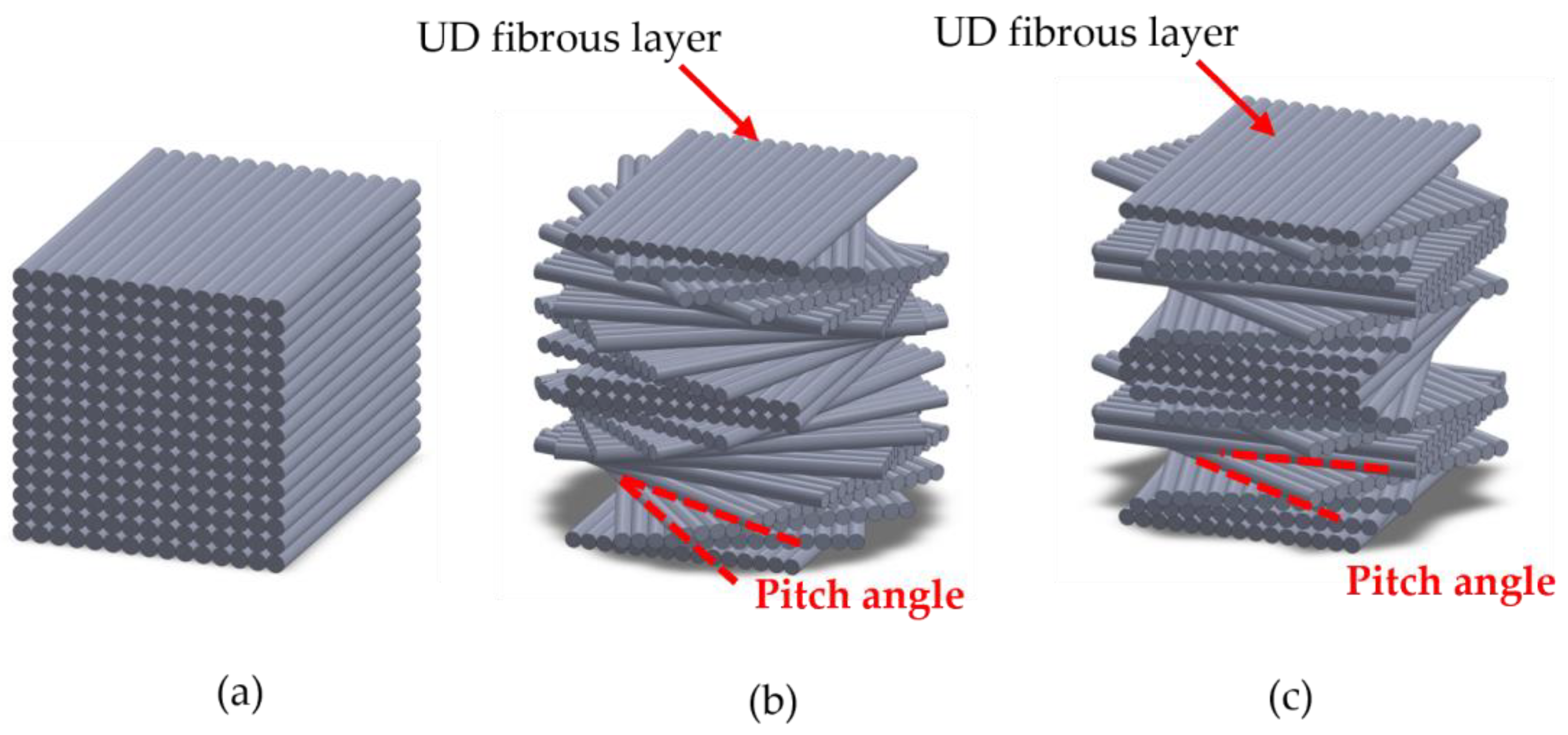
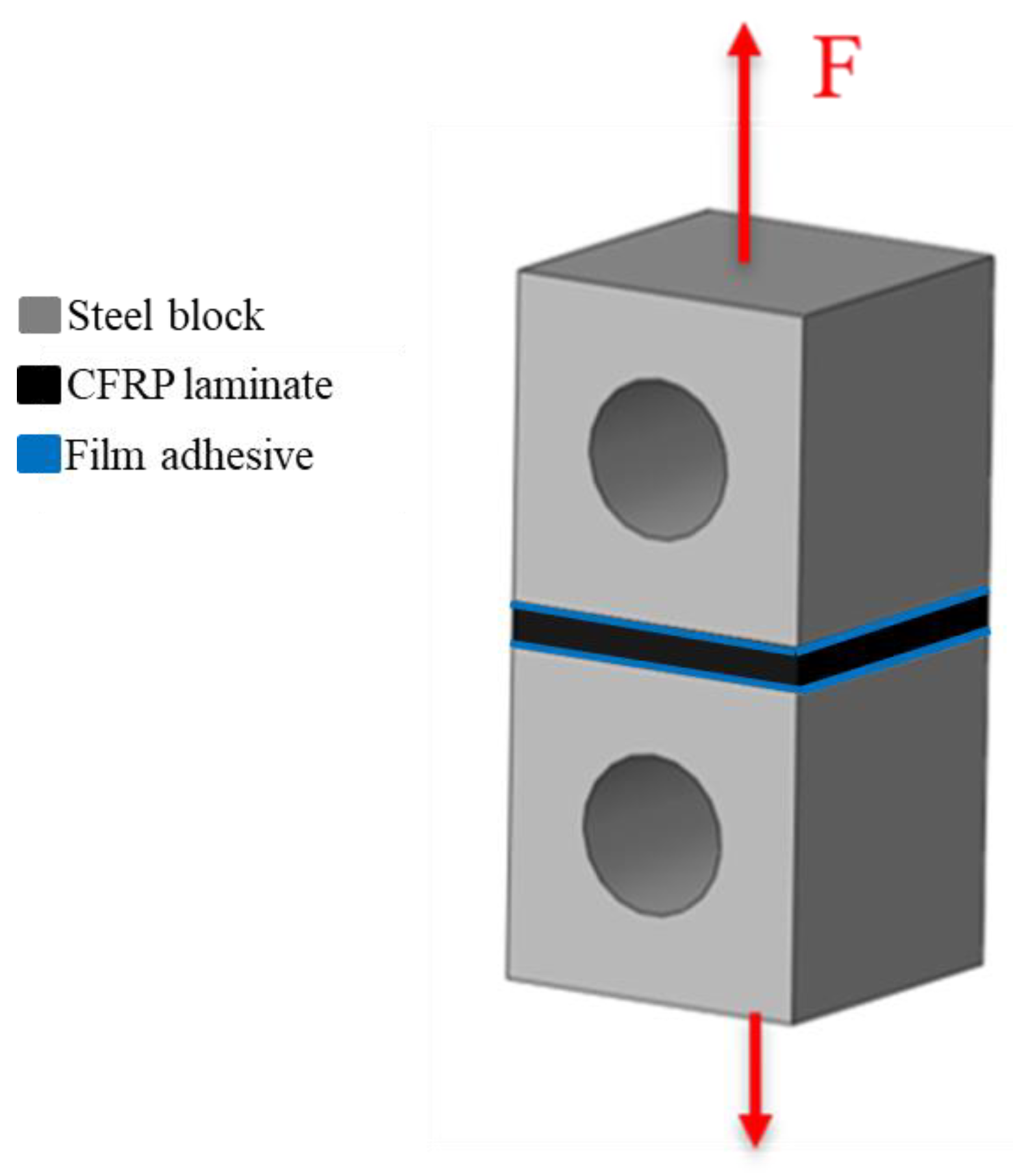
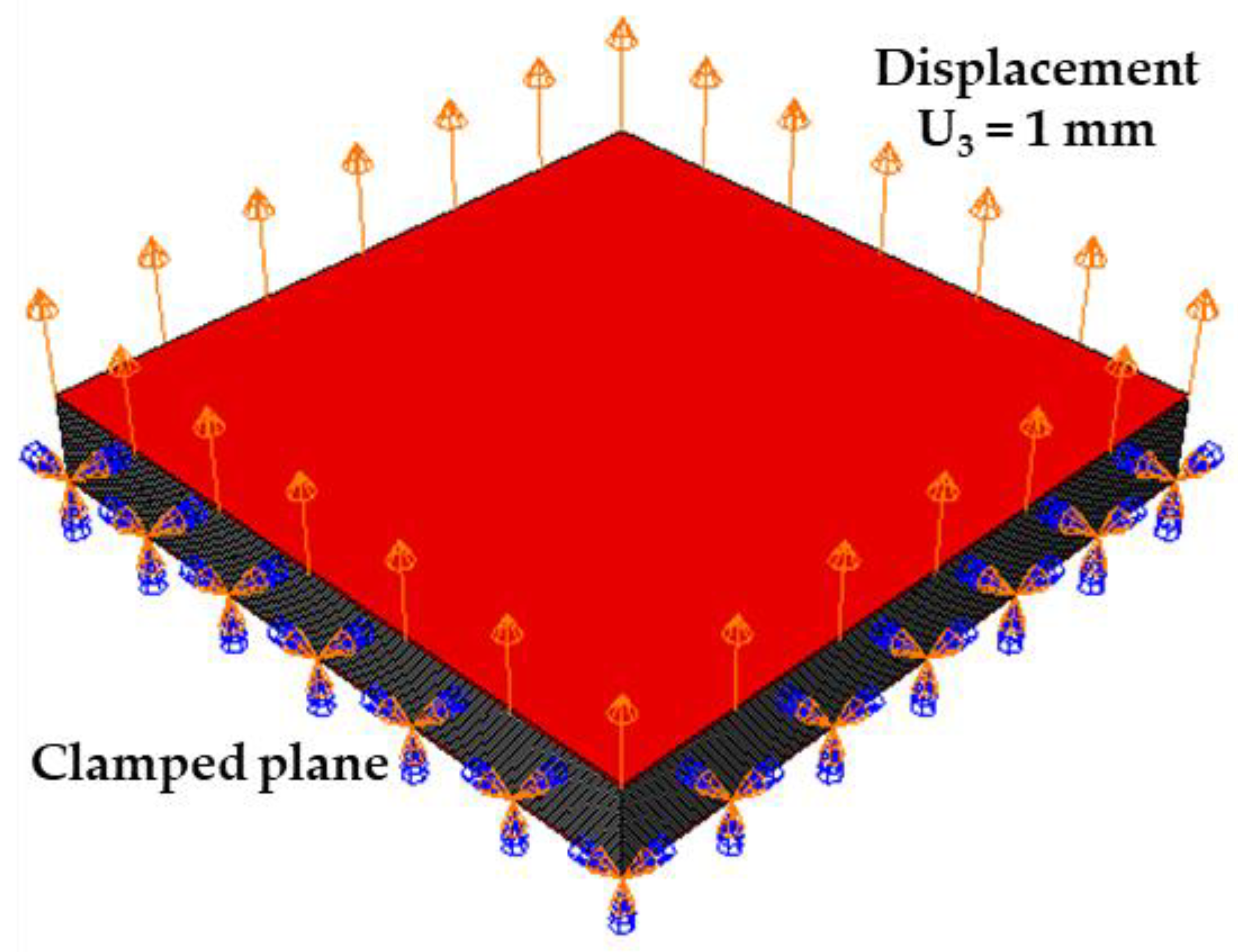

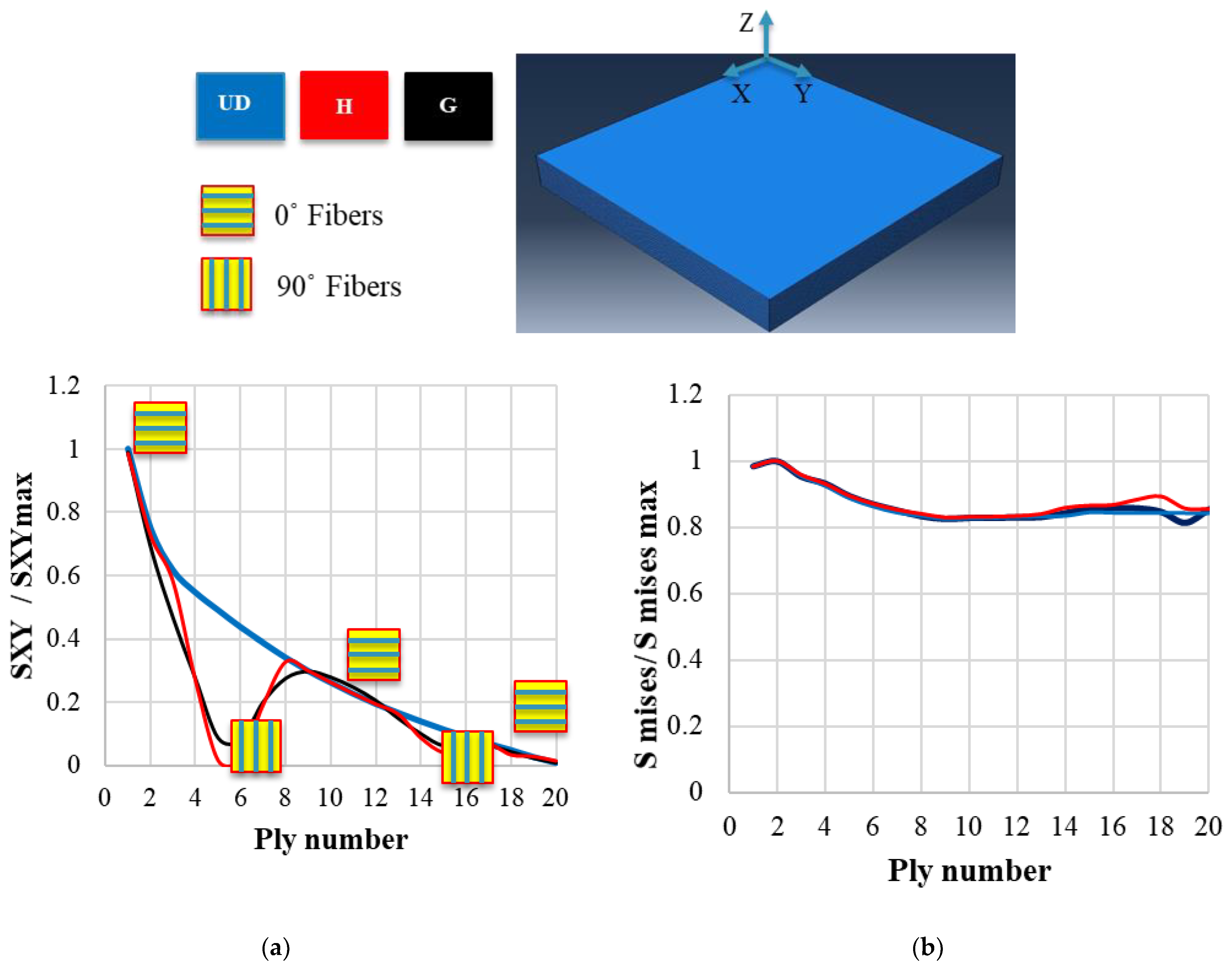
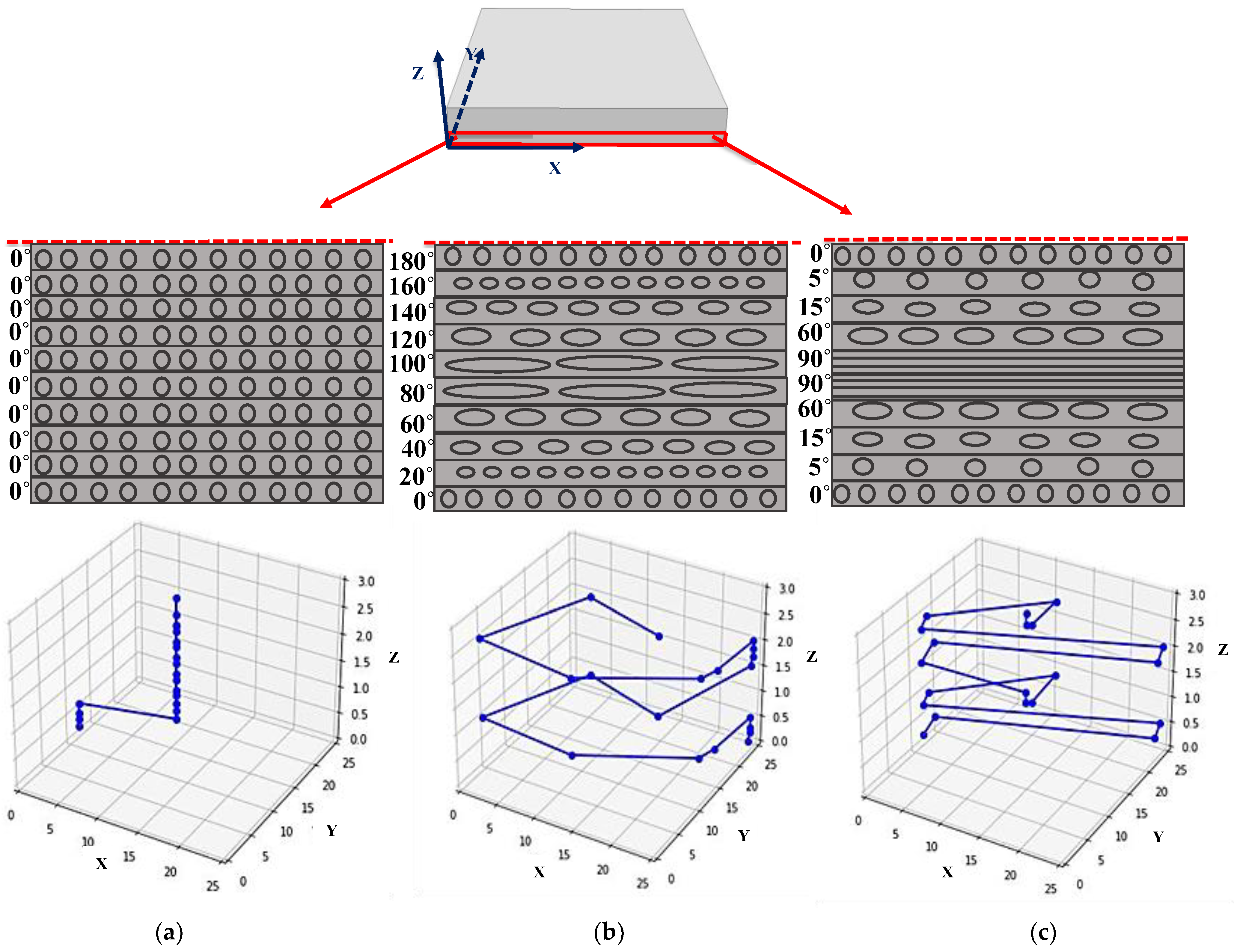
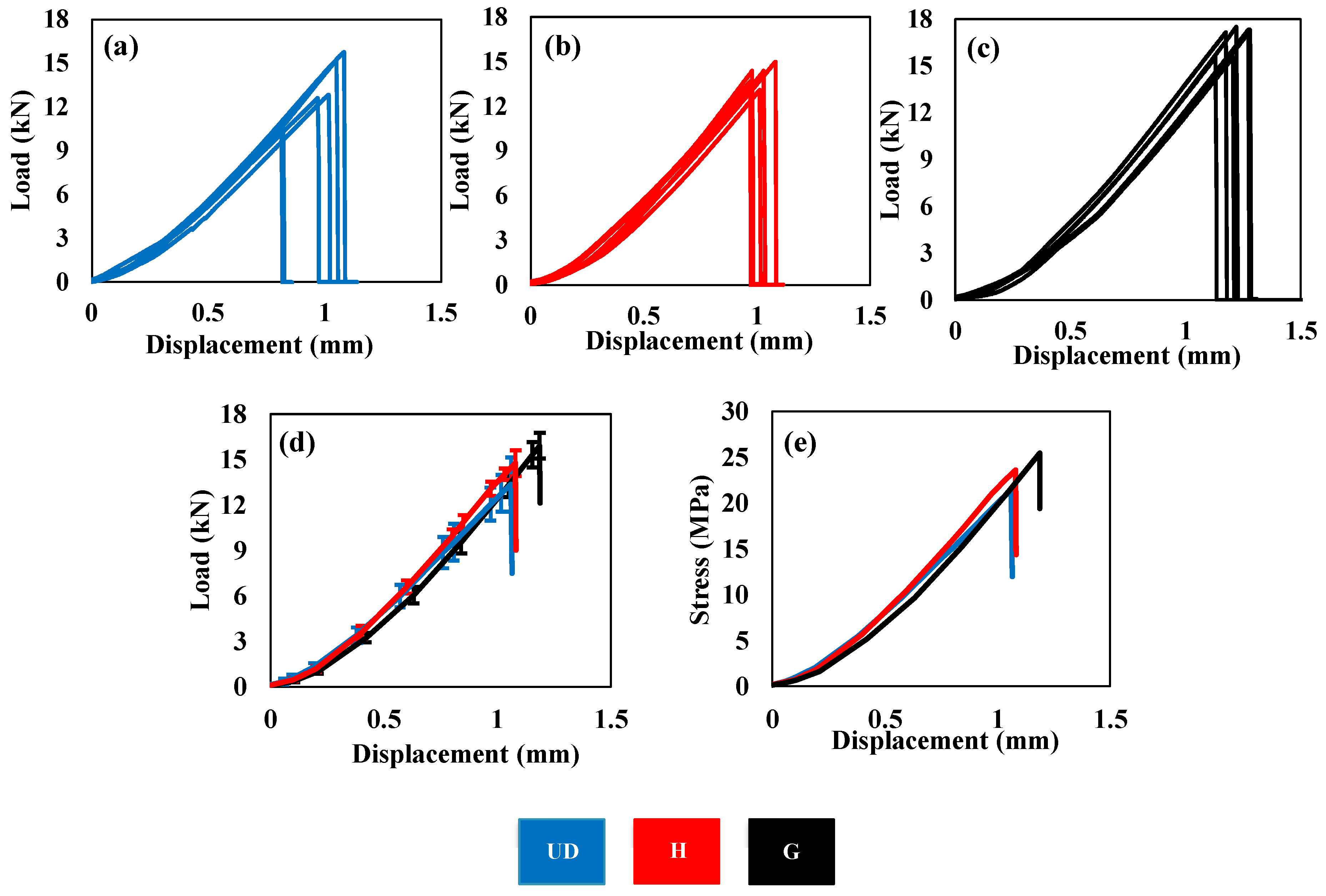
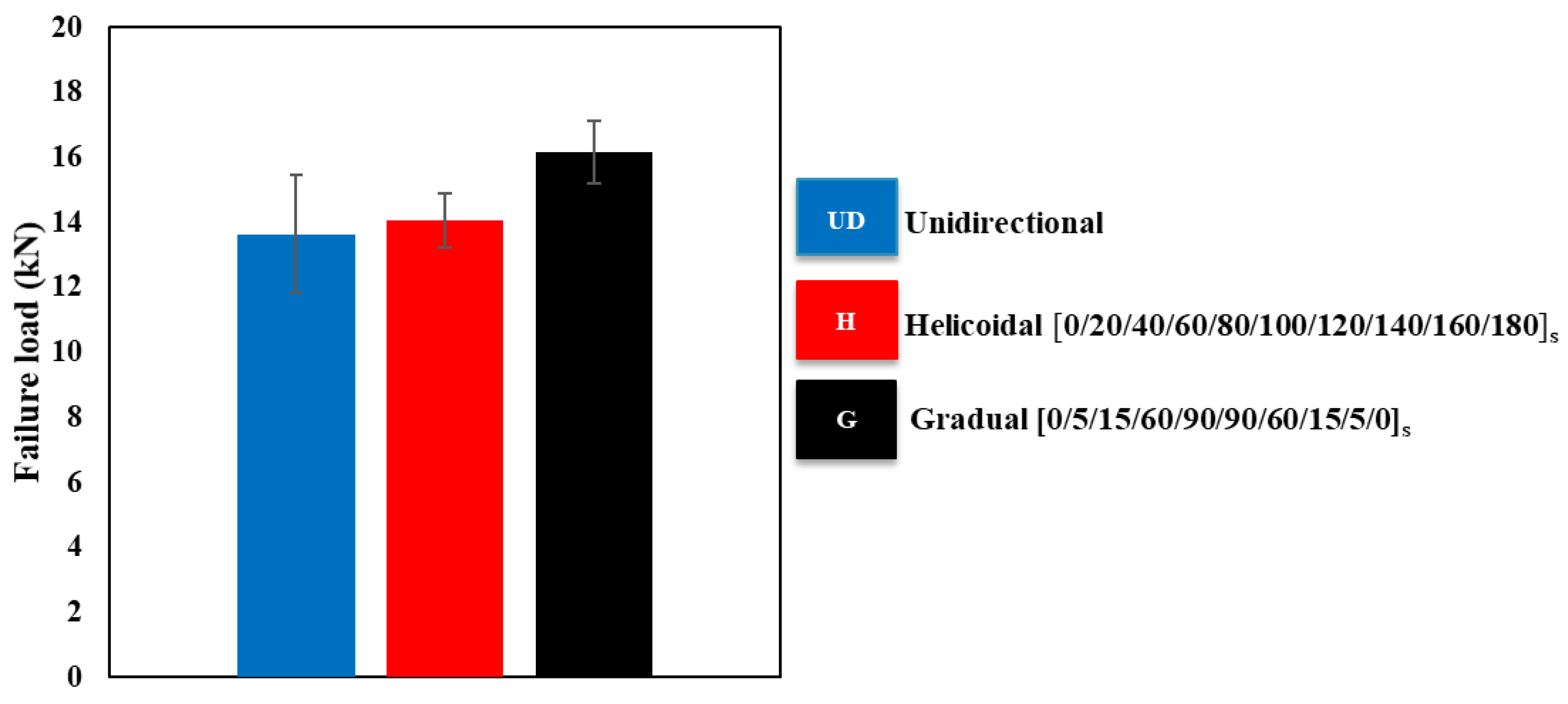
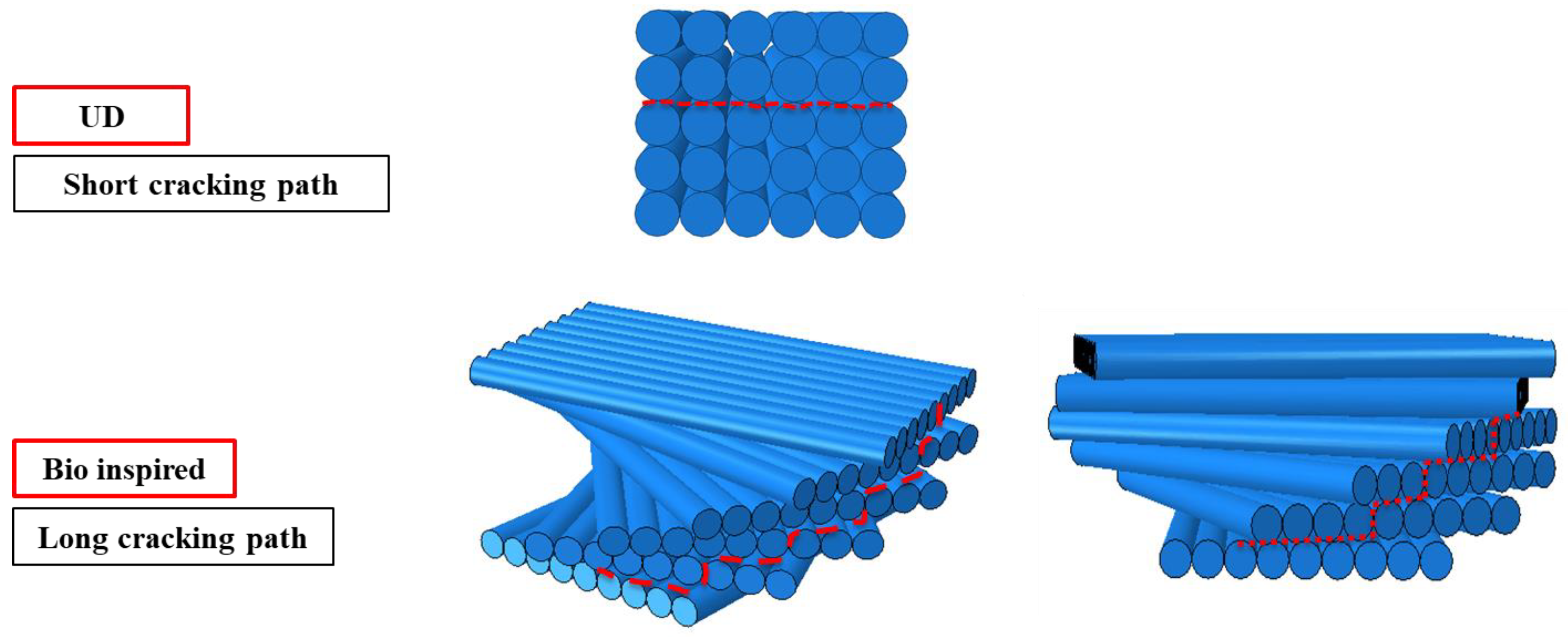
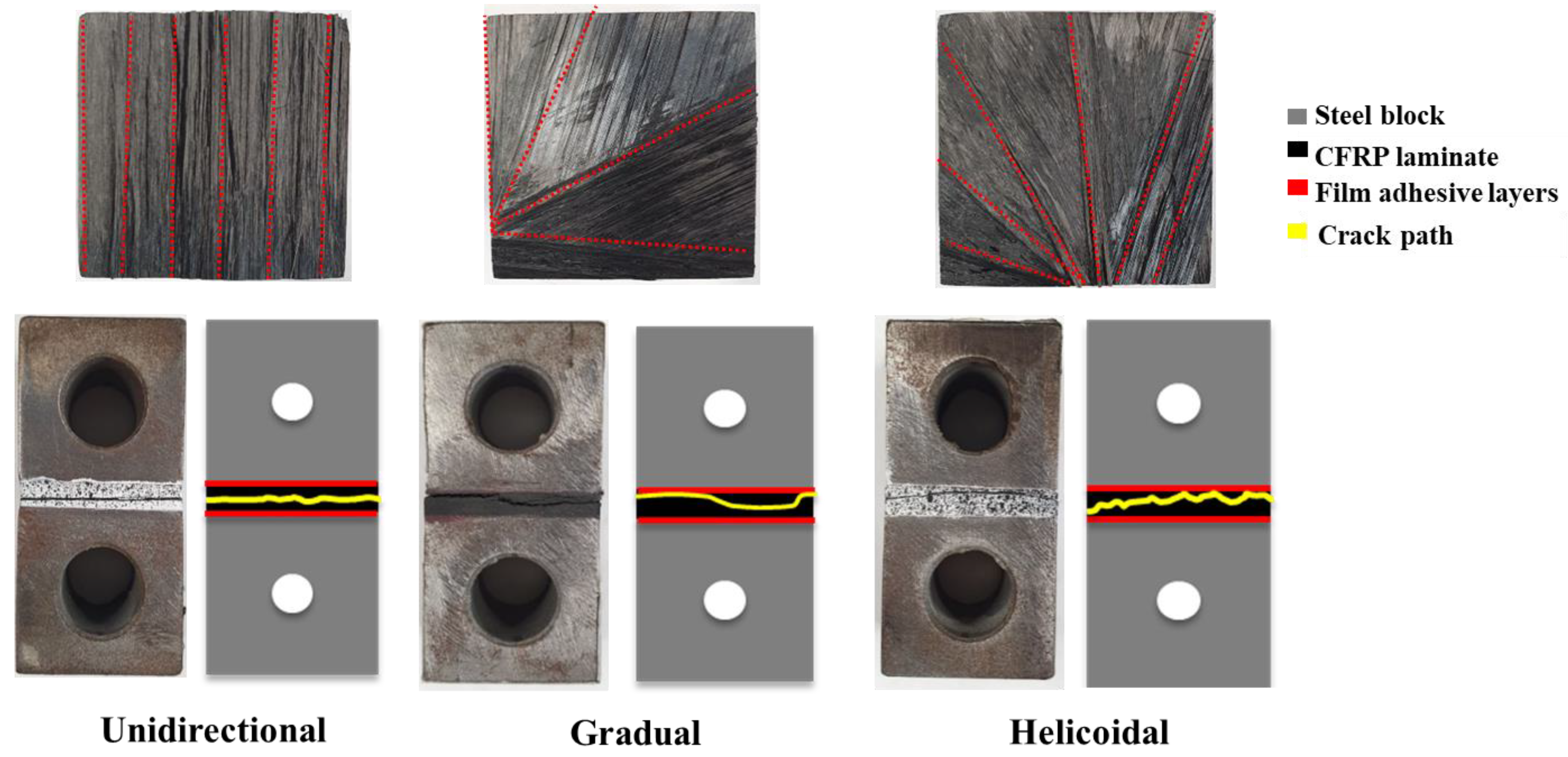
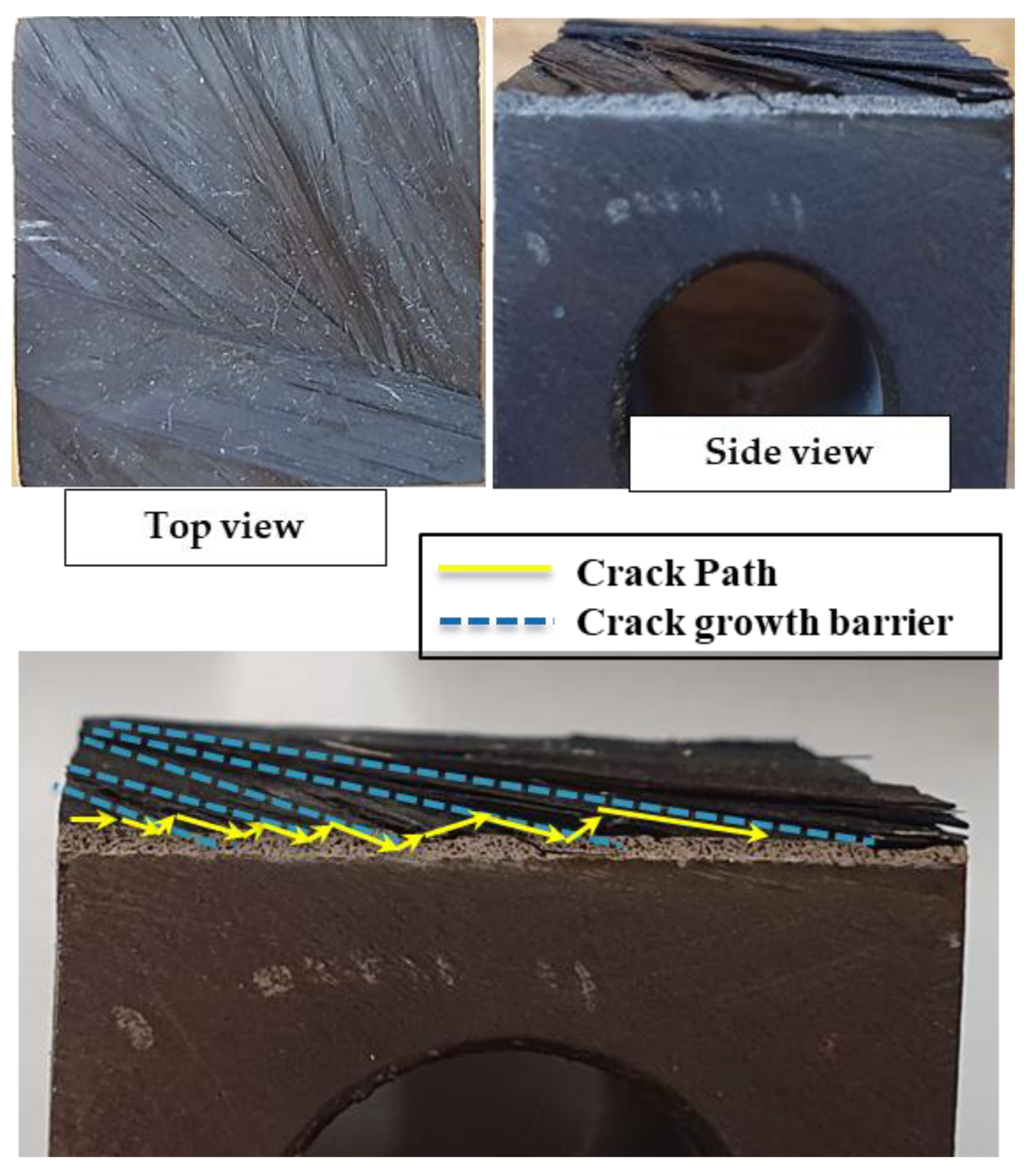
| Laminate Title | Ply Stacking Sequence |
|---|---|
| Unidirectional (UD) | [0]20 |
| Helicoidal (H) | [0/20/40/60/80/100/120/140/160/180]s |
| Gradual (G) | [0/5/15/60/90/90/60/15/5/0]s |
| Ex (Mpa) | Ey (Mpa) | Ez (Mpa) | ʋxy | ʋxz | ʋyz | Gxy (Mpa) | Gxz (Mpa) | Gyz (Mpa) |
|---|---|---|---|---|---|---|---|---|
| 109,000 | 8819 | 8819 | 0.342 | 0.342 | 0.380 | 4315 | 4315 | 3200 |
Disclaimer/Publisher’s Note: The statements, opinions and data contained in all publications are solely those of the individual author(s) and contributor(s) and not of MDPI and/or the editor(s). MDPI and/or the editor(s) disclaim responsibility for any injury to people or property resulting from any ideas, methods, instructions or products referred to in the content. |
© 2024 by the authors. Licensee MDPI, Basel, Switzerland. This article is an open access article distributed under the terms and conditions of the Creative Commons Attribution (CC BY) license (https://creativecommons.org/licenses/by/4.0/).
Share and Cite
Malekinejad, H.; Carbas, R.J.C.; Akhavan-Safar, A.; Marques, E.A.S.; Ferreira, M.; da Silva, L.F.M. Bio-Inspired Helicoidal Composite Structure Featuring Graded Variable Ply Pitch under Transverse Tensile Loading. J. Compos. Sci. 2024, 8, 228. https://doi.org/10.3390/jcs8060228
Malekinejad H, Carbas RJC, Akhavan-Safar A, Marques EAS, Ferreira M, da Silva LFM. Bio-Inspired Helicoidal Composite Structure Featuring Graded Variable Ply Pitch under Transverse Tensile Loading. Journal of Composites Science. 2024; 8(6):228. https://doi.org/10.3390/jcs8060228
Chicago/Turabian StyleMalekinejad, Hossein, Ricardo J. C. Carbas, Alireza Akhavan-Safar, Eduardo A. S. Marques, Maria Ferreira, and Lucas F. M. da Silva. 2024. "Bio-Inspired Helicoidal Composite Structure Featuring Graded Variable Ply Pitch under Transverse Tensile Loading" Journal of Composites Science 8, no. 6: 228. https://doi.org/10.3390/jcs8060228
APA StyleMalekinejad, H., Carbas, R. J. C., Akhavan-Safar, A., Marques, E. A. S., Ferreira, M., & da Silva, L. F. M. (2024). Bio-Inspired Helicoidal Composite Structure Featuring Graded Variable Ply Pitch under Transverse Tensile Loading. Journal of Composites Science, 8(6), 228. https://doi.org/10.3390/jcs8060228









